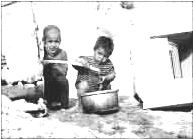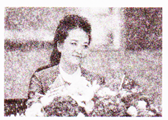| First name |
Wang |
| ID |
211021198508081513 |
| Phone number |
0419-3456789/13900012345 |
| Address |
Room 203, Liaoyang City(市) |
根据表格所提供的有关王老师的信息,选择最佳答案。
My English teacher is _________ .
A. young B. old C. tall
My English teacher is from ___________.
A. China B. the USA C. England
________ is my English teacher.
A. Miss Wang B. Mrs. Wang C. Mr. Wang
My English teacher is on a bus. You can call him/her at ________.
A. Room 203 B. 0419-3456789 C. 13900012345
My English teacher lives in the city(市) of _______ .
A. Liaoyang B. Liaoning C. Wuhu
Why is clean water so important to developing countries?A recent report shows that about 80percent of diseases in developing countries are caused by poor water and low sanitation(卫生)conditions.In those countries,women and girls spend several hours collecting water,but often polluted,far away from their families.The polluted water more or less influences their health.In this case,there is an urgent(迫切的)need for people in developing countries to have access to(有机会或权利使用)clean water to improve their health.
Here is a short story about Hadjara Zakari,a 12﹣year﹣old girl in Niger.Having access to clean water changed her life.She learned about the importance of hand﹣washing when the school first received clean water three years ago.That evening,she told her father,"You shouldn't eat with me unless you clean your hands."Her father was very angry and shouted at her,"It's not up to you to tell me what to do!"Stunned(目瞪口呆的),Hadjara sat in silence.But she knew she was right.In protest,Hadjara refused to eat dinner that night.After her father questioned Hadjara's head teacher,he understood the importance of hand﹣washing and his daughter's intentions(目的).The girl really wanted her family to live longer and healthier lives.
For people in developing countries,clean water can change many things,especially improve their health.So,from now on,let's avoid wasting water and take action to save water,which is important to people all over the world.
51.According to the recent report,poor water and low sanitation conditions can cause .
A.traffic problems
B.forest fires
C.many illnesses
52.The key to improving people's health in developing countries is in Paragraph 1.
A.to get clean water
B.to exercise often
C.to refuse drugs
53.What can we infer(推断)from Paragraph 2?
A.Hadjara laughed at her father's foolishness.
B.Hadjara refused to eat dinner that night in order to lose weight.
C.Hadjara's father understood his daughter's love and care for him later.
54.The underlined word"protest"in this passage means .
A.抗议
B.保护
C.节约
55.The purpose of the writer is to .
A.teach people how to wash hands
B.call on people all over the world to save water
C.show developing countries rich in clean water.

The Lantern Festival falls on the 15th of the first month of the lunar calendar(阴历).This day is always the first full moon in the new year.Ancient people also called it Shangyuan Festival.Celebrations and traditions on this day began from the Han Dynasty(朝代)and became popular in the Tang Dynasty.
Watching the red lanterns is one of the main traditions.Lanterns of different shapes and sizes are usually put on trees,or along river banks on show.It is said that sky lanterns were first used by Zhuge Kongming to ask for help when he was in trouble.Today,when the lanterns slowly rise into the air,people make wishes.
Another tradition is guessing lantern riddles.The riddles are usually short,wise,and sometimes humorous.The answer to a riddle can be a Chinese character(汉字),a famous person's name,or a place name.
The most important thing is to eat sweet dumplings with different tastes.In northern China,they are called yuanxiao while in southern part they're named tangyuan.Because making sweet dumplings is like a game or an activity,they are usually done happily by a group of friends or family members.
In old times,the Lantern Festival was also romantic(浪漫的).Watching lanterns gave young people a chance to meet each other.A line from Xin Qiji,a poet during the Song Dynasty,shows this:
Hundreds and thousands of times I searched for her in the crowd.Suddenly I turned,and there she stood,in the dim(昏暗的)light.
46.The traditional festival talked about in this passage is called" "in Chinese.
A.春节
B.元宵节
C.端午节
47.When did celebrations and traditions of the Lantern Festival start from?
A.The Han Dynasty.
B.The Tang Dynasty.
C.The Song Dynasty.
48.What were sky lanterns first used for by Zhuge Kongming in ancient times?
A.Making wishes.
B.Celebrating birthdays.
C.Asking for help.
49.Which of the following is NOT true about sweet dumplings?
A.They have different tastes.
B.They are named"yuanxiao"all over the country.
C.People enjoy the process of making them.
50.The line from Xin Qiji in the passage shows the Lantern Festival was in old times.
A.boring
B.humorous
C.romantic.

|
|
Theme parks |
|
|
Universal Studios(环球影城) ﹣a dream land for Hollywood movie fans |
The history of movies,the live shows and film tricks(技巧)can be found here and it has parks in the USA,Japan and Singapore. |
|
|
Legoland ﹣a world made of Lego bricks(乐高积木 |
You'll be sent back to your childhood time by the buildings and dolls made of Lego bricks and there are seven Legoland parks in the world and the one nearest to us is in Malaysia. |
|
|
Ferrari World ﹣a paradise(乐园)for car lovers |
You can experience the feeling of driving a Ferrari(法拉利)car and see how Ferrari's racing cars are produced in Abu Dhabi. |
|
43.Lucy is interested in film making.Which park could be the best choice for her?
A.Universal Studios.
B.Legoland.
C.Ferrari World.
44.While an adult is visiting Legoland,what will probably be thought about?
A.His or her childhood.
B.His or her present.
C.His or her future.
45.According to the chart(图表),we know that .
A.we can visit Universal Studios only in America
B.the buildings and dolls at Legoland are made of Lego bricks
C.we can get Ferrari cars for free when we visit Ferrari World.
|
|
Smart Kids Club Fridays & Sunday 5:00 pm to 6:30 pm In the school library For age groups:5﹣10 years old ﹩2.00 each week Register(登记):in the gym Contact(联系):SmartKidsClub2@hotmail.com |
41.Smart Kids Club is open to the members .
A.at 6:00 am on Fridays
B.at 5:00 pm on Saturdays
C.at 5:30 pm on Sundays
42.If Mrs.Black's twin daughters of 8 both join the club,how much should she pay each week?
A.﹩2.
B.﹩4.
C.﹩16.
Peng Liyuan.First Lady of China,made a speech in English at the United Nations on September 26.She talked about education and shared her Chinese dream with the world.
Peng began her speech with a story of her father.Her father grew up in a small village in China.In those days,not many villagers could read,so her father opened a night school to teach them.With his help,many people learned to write their names and read newspapers for the first time.And many women were able to teach their children how to read.Peng's father's love for education influenced her deeply.She was lucky enough to have a good education.Later,she followed her father's footsteps and became a professor of music.
Education is important,but still,some children in China can't go to school.Peng hopes that all children can have a good education,and that is her Chinese dream.
51.In what language did Peng Liyuan give her speech at the United Nations? .
52.What's Peng Liyuan's speech about? .
53.Did Peng begin her speech with a story of her father? .
54.Where did Peng's father grow up? .
55.What's Peng Liyuan's Chinese dream? .
